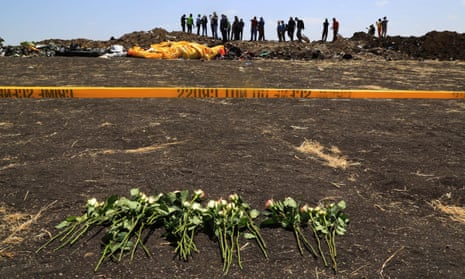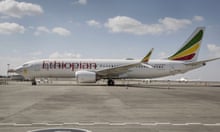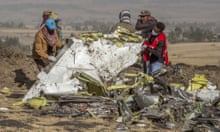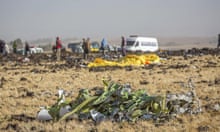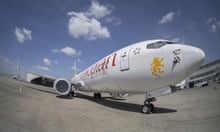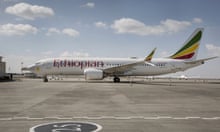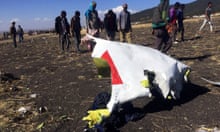The pilot of Ethiopian Airlines flight 302 told controllers he was having control problems before the Boeing 737 Max 8 jet crashed, according to an account of cockpit voice recordings from the airline’s chief executive.
The pilot did not mention bird strikes or external problems, but requested permission to return to Bole airport in Addis Ababa within minutes of takeoff. The pilot “reported back to air traffic controllers that he was having flight control problems”, but cited no other issues, Tewolde GebreMariam told the Wall Street Journal.
The airline is planning to send the plane’s flight data recorder to Europe rather than the US for analysis, he said.
Flight 302 was bound for Nairobi when it plunged to the ground shortly after takeoff on Sunday, killing all 157 people onboard. It was the second crash involving the 737 Max 8 model in less than five months, after the Lion Air disaster off Indonesia, in which 189 people died in October.
No evidence has yet linked the crashes, but pilots on both planes reported problems moments after takeoff and asked to make emergency landings.
Canada’s transport minister announced on Wednesday that it would bar commercial 737 Max flights from its airspace, leaving the US virtually isolated in allowing the model to fly. Canada lost 18 of its citizens in the Ethiopia crash, the second highest number after Kenya.
European regulators have already grounded the 737 Max, along with China, Australia, India and others around the world. The US Federal Aviation Administration (FAA), Boeing and US airlines continue to maintain the 737 Max is safe to fly.
The decision by Canada, where Air Canada, WestJet and Sunwing Airlines operate 41 of the 737s, will further fuel pressure in the US on regulators to act.
In response to public fears expressed about the plane, some travel booking websites such as Kayak are allowing customers to exclude the aircraft types from searches, as nervous passengers seek alternative flights.
It has emerged pilots on at least two US flights last year filed safety concerns about the aircraft after its nose tilted down suddenly when they engaged the autopilot.
The pilots’ reports were filed in a database compiled by Nasa that does not reveal the airlines or locations.
On one flight, the co-pilot said the nose pitched downward and the plane began descending at 1,200 to 1,500ft a minute before the captain disconnected the autopilot.
Another pilot complained Boeing had not explained changes to the plane’s automatic functions, describing the flight manual as “inadequate and almost criminally insufficient”.
The FAA said it was continuing to review all data from operators and pilots, but the review so far showed “no systematic performance issues and provides no basis to order grounding the aircraft. Nor have other civil aviation authorities provided data to us that would warrant action.”
In the US, American Airlines and Southwest Airlines operate the Max 8, and United Airlines flies a slightly larger version, the Max 9. All three carriers vouched for the safety of Max aircraft on Wednesday.
US crew unions, however, have called for the planes to be grounded, and politicians at the highest level, including the president, Donald Trump, have aired doubts.
Airplanes are becoming far too complex to fly. Pilots are no longer needed, but rather computer scientists from MIT. I see it all the time in many products. Always seeking to go one unnecessary step further, when often old and simpler is far better. Split second decisions are....
— Donald J. Trump (@realDonaldTrump) March 12, 2019
....needed, and the complexity creates danger. All of this for great cost yet very little gain. I don’t know about you, but I don’t want Albert Einstein to be my pilot. I want great flying professionals that are allowed to easily and quickly take control of a plane!
— Donald J. Trump (@realDonaldTrump) March 12, 2019
The Republican senator Ted Cruz, who chairs the Senate subcommittee that oversees aviation, said it would be prudent for the US to temporarily ground the aircraft “until the FAA confirms the safety of these aircraft and their passengers”.
Boeing said: “We understand that regulatory agencies and customers have made decisions that they believe are most appropriate for their home markets. We’ll continue to engage with them to ensure they have the information needed to have confidence in operating their fleets.”
The manufacturer is to face a slew of compensation claims from airlines around the world whose 737 Max fleets have been grounded.
Norwegian said it would be pursuing the US manufacturer for costs and lost revenue after being forced to take 18 planes out of service, as the Civil Aviation Authority in the UK and the European Aviation Safety Agency banned the Max 8. Dozens of flights have been cancelled at the airline, which is already in a precarious financial situation. Norwegian told Reuters: “We expect Boeing to take this bill.”
The airline, which has been operating low-cost transatlantic flights as well as short-haul using the single-aisle Max 8, has orders that will quadruple its fleet of the planes by 2021. Norwegian’s share price fell 10% this week following the crash.
Analysts said the situation would become serious for Norwegian if it persisted into the peak Easter season, when demand would mean there was no spare capacity.
Many other airlines have schedules planned around deliveries of the 737 Max, which could be affected by a prolonged grounding. Ryanair expects the first of 135 Max 200s to be delivered in the spring, with more than 50 due in service by summer 2020.
Meanwhile, Germany’s Federal Bureau of Aircraft Accident Investigation said it would not analyse the black box from the Ethiopian Airlines jet.
“This is a new type of aircraft with a new black box, with new software. We can’t do it,” said the BFU spokesman Germout Freitag.
A spokesman for Ethiopian Airlines had earlier said the black boxes recovered from the crashed plane would be sent to Germany for analysis.
